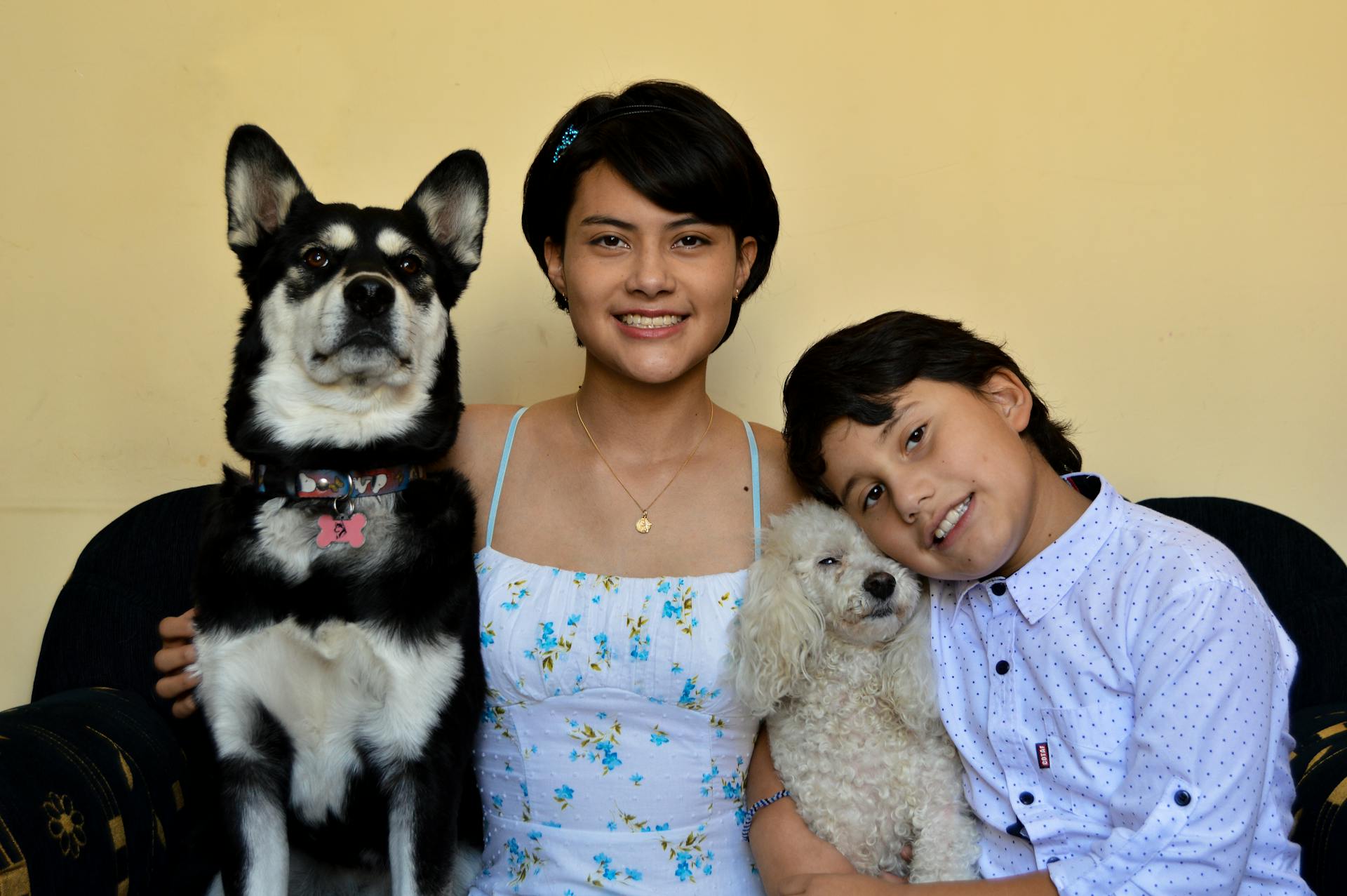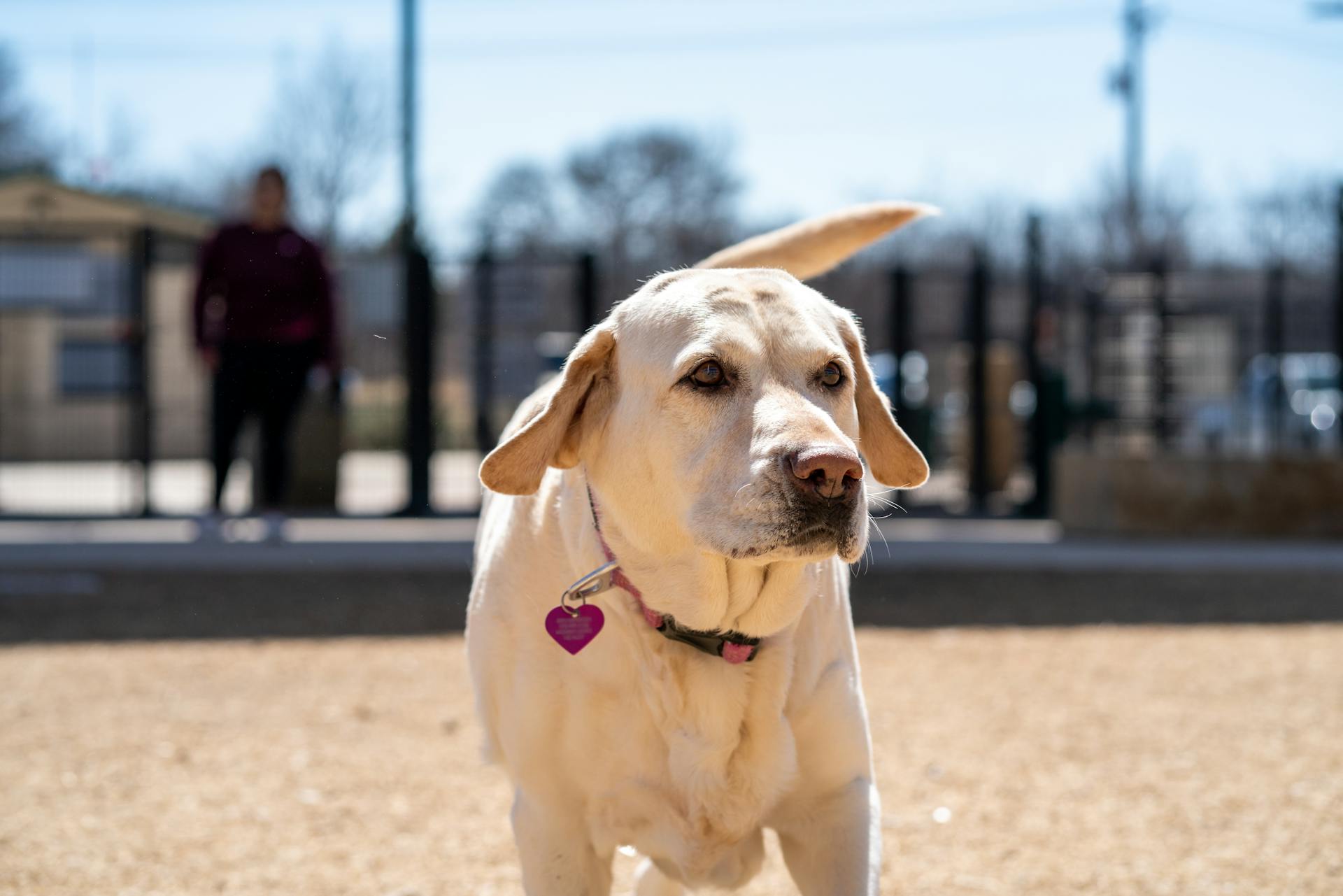
Dogs need regular exercise to stay healthy and happy. Aim for at least 30 minutes of physical activity per day, such as a brisk walk or playtime in the park.
Their diet is also crucial, and feeding them high-quality dog food that meets their nutritional needs is essential. A balanced diet will help prevent obesity and related health issues.
Regular veterinary check-ups are vital to monitor their health and catch any potential issues early on. Your vet can help you create a preventative care plan tailored to your dog's specific needs.
By prioritizing exercise, nutrition, and veterinary care, you can help your furry friend live a long, healthy, and happy life.
A fresh viewpoint: How to Take Care of Pug Dog
Evolution and History
Dogs descended from a Eurasian wolf ancestor, not the gray wolf. This ancestor is now extinct, and scientists are still working to understand exactly what species gave rise to dogs.
Genetic evidence suggests that dogs broke off from their wild ancestors between 15,000 and 30,000 years ago. This is a significant period of time, and it's likely that the process of domestication happened gradually over thousands of years.
As wolves became more comfortable with humans, they may have started eating human scraps and eventually, humans began actively feeding them. This could have led to the wolves being welcomed into human homes and eventually bred to encourage certain traits.
The earliest remains of a domesticated dog were discovered in Bonn-Oberkassel, Germany, and date back to 14,223 years ago. This dog was buried with a man and a woman, all three having been sprayed with red hematite powder and buried under large, thick basalt blocks.
DNA sequences show that all ancient and modern dogs share a common ancestry and descended from an ancient, extinct wolf population. This population was distinct from any modern wolf lineage.
Genetic studies suggest a domestication process commencing over 25,000 years ago, in one or several wolf populations in either Europe, the high Arctic, or eastern Asia. Some studies have suggested that the extinct Japanese wolf is closely related to the ancestor of domestic dogs.
A study identified 429 genes that differed between modern dogs and modern wolves. These genes are linked to neural crest and central nervous system development, and could have contributed to the domestication of dogs.
Biology and Anatomy
Dogs are incredibly variable in size, ranging from the massive Great Dane to the tiny Chihuahua.
Their skeletons are well adapted for running, with extensions on the vertebrae for back muscles and long ribs that provide room for the heart and lungs.
The shoulders are unattached to the skeleton, allowing for flexibility.
Dogs have 26 vertebrae in their tails, but some breeds have as few as three due to natural selection for short tails.
Their skulls have identical components, but vary significantly in shape between breeds, with three main types: elongated, intermediate, and very short and broad.
Dogs use their 42 teeth to cut food into bite-sized chunks, especially meat.
Their tails are not just for balance and communication, but also help spread their anal gland's scent through movement and position.
For another approach, see: Dog Breeds Watch Dogs
Anatomy and Physiology
Dogs are incredibly variable in size, ranging from the massive Great Dane to the tiny Chihuahua.
Their skeletons are well adapted for running, with vertebrae on the neck and back designed to connect with powerful back muscles. The long ribs also provide room for the heart and lungs.
The dog's skull has identical components regardless of breed type, but there's significant divergence in terms of skull shape between types. This is evident in the elongated dolichocephalic type seen in sighthounds.
Dogs have around 42 teeth in their jaw, which have evolved for the consumption of flesh. They use their carnassial teeth to cut food into bite-sized chunks, especially meat.
A dog's tail is made up of 5 to 23 vertebrae enclosed in muscles and skin that support the dog's back extensor muscles. The tail plays a crucial role in communicating a dog's emotional state.
Dogs can injure themselves by wagging their tails forcefully, a condition known as kennel tail or happy tail.
A unique perspective: Food for Dogs with No Teeth
Senses
Dogs' sense of smell is incredibly powerful, with some breeds having up to 300 million smell-sensitive receptors.
Their sense of hearing is also impressive, with dogs able to pick up sounds from up to 400 meters away, four times farther than humans can.
Check this out: Dog Smell
Dogs have a unique way of sensing their environment through their whiskers, which are stiff and deeply embedded hairs that detect atmospheric changes and vibrations.
Whiskers contain more receptor cells than other hair types, helping dogs detect objects that could collide with their nose, ears, and jaw.
Dogs' vision is dichromatic, meaning they see the world in shades of yellow, blue, and gray, with difficulty differentiating between red and green.
Their visual acuity is significantly lower than humans, with dogs being up to 8 times less effective at seeing detail.
Dogs are able to detect small variations in Earth's magnetic field, which helps them navigate and even choose where to defecate.
Coat
Dogs come in a wide variety of coat types, with some breeds having a double coat made up of a coarse guard hair and a soft down hair.
This type of coat is common in dogs from colder climates and is also found in wolves.
Some breeds have a single coat with only a topcoat, while others are hairless altogether.
A few breeds have a very thick corded coat, which can be quite a challenge to groom.
Breeds like the Yorkshire Terrier are often groomed to a specific style, such as the "show cut".
Reproduction
Sexual maturity in dogs typically happens between six months to one year of age, with some large breeds taking up to two years to mature.
Both males and females will experience their first estrous cycle at this time, which can last anywhere from four to 20 days.
During this cycle, the female dog's vulva will swell and produce discharges, signaling her readiness for pregnancy.
Fertilization can occur up to a week after ovulation, allowing multiple males to sire the same litter.
The male and female will become "coitally tied" for around 5-30 minutes after ejaculation due to the male's bulbus glandis swelling and the female's constrictor vestibuli contracting.
The embryo attaches to the uterus about 14-16 days after ovulation, and a heartbeat becomes detectable after an additional 7-8 days.
Dogs typically give birth to their litters around 58-68 days after fertilization, with an average gestation period of 63 days.
For another approach, see: Why Does My Male Dog Keep Licking My Female Dog
Terminology
Understanding the terminology used in biology and anatomy is crucial to grasping the concepts.
A cell is the basic structural and functional unit of living organisms, and it's the smallest unit of life.
In anatomy, the nervous system refers to the complex system that controls and coordinates the body's functions.
The human body is made up of 206 bones, which provide support and protection for internal organs.
Anatomical terms like dorsal and ventral are used to describe the body's orientation and position of organs.
The circulatory system transports blood throughout the body, supplying oxygen and nutrients to tissues.
Breeds and Classification
There are around 450 official dog breeds, the most of any mammal. These breeds have undergone rapid phenotypic change and have been subjected to artificial selection by humans.
Most breeds were derived from small numbers of founders within the last 200 years. This is a relatively short period of time, especially when compared to other animals.
Dogs have been bred to fill a wide range of roles, including herding, hunting, and companionship. For example, the labradoodle was invented as an attempt to create a hypoallergenic guide dog.
Here are the main groups into which breeds are classified:
- Sporting Group
- Hound Group
- Working Group
- Terrier Group
- Toy Group
- Non-Sporting Group
- Herding Group
- Miscellaneous Class
- Foundation Stock Service
Dog Breeds
There are around 450 official dog breeds, the most of any mammal. This staggering number is a testament to humans' ability to selectively breed dogs for desirable traits.
Dogs have undergone rapid phenotypic change in recent history, with most breeds derived from small numbers of founders within the last 200 years. This selective breeding has led to incredible diversity in dog breeds.
The skull, body, and limb proportions between breeds display more phenotypic diversity than can be found within the entire order of carnivores. This is a remarkable example of how humans have shaped the physical characteristics of dogs.
Many breeds were created to fill specific human needs, such as herding livestock or hunting game. For instance, German shepherds were bred for herding, while Labrador retrievers were bred to help hunters collect felled game.
The labradoodle, a cross between a Labrador retriever and a poodle, was invented as an attempt to create a hypoallergenic guide dog. This is just one example of how humans have selectively bred dogs for desirable traits, such as low-shedding coats.
Suggestion: Australian Cattle Dog Herding Dogs
Group
Let's talk about the different groups of dog breeds. There are nine main groups, which can help you narrow down the perfect breed for you.
The Sporting Group is all about energy and enthusiasm, featuring breeds like Retrievers and Spaniels. These dogs love to run and play.
The Hound Group is made up of breeds that are born to hunt, with keen senses and a strong prey drive.
The Working Group is comprised of breeds that were originally bred for jobs like guarding and pulling carts. They're strong and capable dogs.
The Terrier Group is all about feisty little dogs that are full of spirit and courage. They're perfect for families who want a small but mighty companion.
The Toy Group is for breeds that are, well, toys! They're small, cute, and love to be pampered.
The Non-Sporting Group is a bit of a mix, featuring breeds that don't really fit into any other category. They're often unique and quirky.
If this caught your attention, see: Service Dog Vest for Small Dogs
The Herding Group is for breeds that were originally bred to help with herding livestock. They're intelligent and active dogs.
Here are the nine main groups, listed out for you:
- Sporting Group
- Hound Group
- Working Group
- Terrier Group
- Toy Group
- Non-Sporting Group
- Herding Group
- Miscellaneous Class
- Foundation Stock Service
The Miscellaneous Class and Foundation Stock Service are two special groups that don't fit into the main categories. They're often for breeds that are still being developed or recognized.
Health and Wellness
Dogs can be a significant source of health risks, particularly for children, who are more likely to sustain serious injuries from dog bites. Sharp claws can lacerate flesh and cause serious infections.
Dog bites affect tens of millions of people globally each year, and in the United States, cats and dogs are a factor in more than 86,000 falls each year. Dog-associated road accidents involving injuries more commonly involve two-wheeled vehicles.
However, dogs can also have a positive impact on human health and wellness. Studies have shown that people with pet dogs take considerably more physical exercise than those with cats or those without pets.
For another approach, see: Dog Bites
Dewclaw
A dog's dewclaw is the fifth digit in its forelimb and hind legs.
Dewclaws on the forelimbs are attached by bone and ligament, while the hind legs are attached only by skin.
Most dogs aren't born with dewclaws in their hind legs.
Dogs' dewclaws consist of the proximal phalanges and distal phalanges.
Some publications theorize that dewclaws in wolves, who usually do not have dewclaws, were a sign of hybridization with dogs.
Health
Dogs can acquire a wide range of health issues, including upper respiratory tract diseases, heart diseases, and gastrointestinal diseases.
Many dogs are prone to heart diseases, including cardiovascular inflammation or dysfunction of the heart.
Dogs can also develop gastrointestinal diseases, such as diarrhoea and gastric dilatation volvulus.
In addition to these issues, dogs can acquire liver failure, pancreatitis, and renal disease.
Some dogs may also develop endocrine disorders, such as diabetes mellitus, Cushing's syndrome, hypoadrenocorticism, and hypothyroidism.
Dogs can also be affected by nervous system diseases, such as seizures and spinal injury.

Musculoskeletal diseases, such as arthritis and myopathies, are also common in dogs.
Dermatological disorders, such as alopecia and pyoderma, can also affect dogs.
Ophthalmological diseases, such as conjunctivitis, glaucoma, entropion, and progressive retinal atrophy, are also prevalent in dogs.
Neoplasia is the most common cause of death in dogs.
Dogs can also be a source of zoonoses for humans, including rabies, hydatid disease, leptospirosis, pasteurellosis, ringworm, and toxocariasis.
The ASPCA animal poisoning hotline receives over 80% of reports of exposure to toxins due to oral exposure.
The most common substances people report exposure to are pharmaceuticals, toxic foods, and rodenticides.
Human drugs are the most frequent cause of toxicosis death in dogs.
Lifespan
Dogs typically live for about 12.7 years, but this can vary greatly depending on their breed and size.
Obesity is a major factor in reducing a dog's lifespan, with one study finding that obese dogs live about a year and a half less than their healthy-weight counterparts.

In a recent UK study, researchers analyzed over 584,000 dogs and found that purebred dogs live longer than crossbred dogs, challenging the previous notion that crossbred dogs have higher life expectancies.
Fully mongrel dogs live about a year longer on average than dogs with pedigrees, and small dogs with longer muzzles tend to live longer than larger dogs with more depressed muzzles.
For free-ranging dogs, less than 1 in 5 reach sexual maturity, and the median life expectancy for feral dogs is less than half of dogs living with humans.
The common saying that one human year equals seven dog years is a simplification, as a dog's aging rate is based on its size and breed.
Neutering
Neutering is a surgical procedure that can have both positive and negative effects on a dog's health.
Spaying a female dog reduces the risk of developing cancers affecting the mammary glands, ovaries, and other reproductive organs.
However, neutering increases the risk of urinary incontinence in female dogs and prostate cancer in males.
In the US, neutering is often performed on puppies as young as 6-14 weeks old, especially in shelters.
The American Society for the Prevention of Cruelty to Animals (ASPCA) recommends neutering dogs that are not intended for breeding to prevent unwanted litters.
In contrast, some European countries have laws that restrict or prohibit early-age neutering, such as Norway, where it's only allowed for health reasons.
Neutering can also lead to health issues like obesity and diabetes mellitus in dogs, regardless of sex.
Diet
Dogs are typically described as omnivores, but they have some unique dietary needs that set them apart from both wolves and humans.
Dogs from agricultural societies have extra copies of amylase and other genes involved in starch digestion, allowing them to thrive on a starch-rich diet.
Some dog breeds produce amylase in their saliva and are classified as having a high-starch diet, similar to humans.
Dogs can't produce their own vitamin D and must get it from consuming other animals.
They also require a diet rich in certain amino acids, including arginine, which is essential for maintaining nitrogen balance.
Here are some amino acids that dogs can't synthesize on their own:
- Arginine
- Histidine
- Isoleucine
- Leucine
- Lysine
- Methionine
- Phenylalanine
- Threonine
- Tryptophan
- Valine
Frequently Asked Questions
What animals are called dogs?
Dogs are classified as a subspecies of Canis lupus, which also includes wolves and dingoes. They are a domesticated member of the Canidae family.
What are the 11 pet animals?
Common pet animals include goats, rabbits, birds, cats, dogs, fish, rats, horses, tortoises, sheep, and ducks. These animals are often kept as companions and can provide affection and entertainment.
Why are dogs called dogs?
The origin of the word "dog" is unclear, but one theory suggests it may come from an Old English term meaning "good/useful animal." This theory proposes that the word was originally an affectionate epithet used by children to describe their canine companions.
Featured Images: pexels.com


